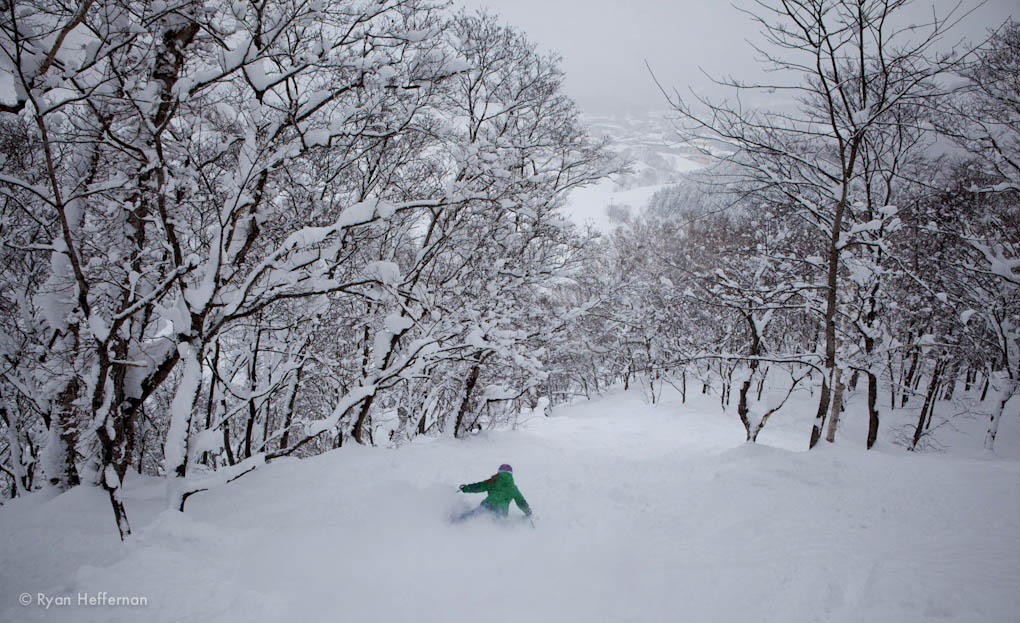
Ski: 2013-2014 Volkl Shiro, 183cm
Dimensions (mm): 151-119-135
Sidecut Radius: 26.4 meters
Actual Tip-to-Tail Length (straight tape pull): 182.0cm
Boots / Bindings: Rossignol Radical World Cup 110 and Dynafit Gaia / Marker F12 (DIN at 8)
Mount Location: Factory Recommended
Test Location: Niseko, Japan; Alta Ski Area; Summit County and Crested Butte, Colorado
Days Skied: 6
[Editor’s Note: Our review was conducted on the 12/13 Shiro, which was not changed for 13/14, except for the graphics.]
Before I dive in and start talking about the Shiro, I ought to give a little background. To really understand how I shaped my thoughts on this ski, it’s best I start with my time on the Volkl Kiku.
I was able to spend an entire season last winter on the 170cm Volkl Kiku, and was overall happy with the ski on most days. But the Kiku was also the first freeride ski I had ever ridden coming off the race circuit. While I believe I had a very good sense of the ski after a season on it, I also recognize that I didn’t have a strong point of reference.
This winter I had the opportunity to test a wide range of skis and could determine what width, length, and shape I like best. I found that, on average, I prefer a longer and wider ski, especially on powder days. (I know, shocker.)
The Kiku, at 107mm underfoot, stands at the top of Volkl’s women freeski lineup; although it is a wide ski, there were times when I was left wanting more. The Kiku is offered in a 178cm length, but I wasn’t able to try it.
For those ladies looking to charge with a little more ski underfoot, then, the Shiro is the next logical progression in the Volkl lineup, and an enticing option.
It seems quite fitting that “shiro” is the Japanese word for white—my time on the Shiro in Niseko, Japan, could be characterized simply as that. We were blessed with seemingly endless days of powder, and our last day before heading home was no exception. I spent most of the day lapping the trees of Miharashi on Grand Hirafu, which still had about 12” of untouched snow well into the afternoon.
My first impression of the Shiro was excellent. I hadn’t spent much time on skis longer than 180cm recently, and I was expecting a bit of a learning curve in the tight trees.

The Shiro, however, felt almost effortless as I picked my way through the birch trees, searching out stretches of untracked snow. Despite their length, the ski felt surprisingly nimble and light, and small, quick turns were not an issue. And at the same time, in wider sections, I could comfortably accelerate to pretty fast speeds while maintaining control, something I did not experience to the same degree on shorter skis.
Because the Shiro is marketed primarily as a powder ski, it is important that the ski not only provide enough float, but feel great in powder, too. I am happy to report the Shiro exceeded my expectations in terms of flotation, while also providing a surfy and stable ride, in part due to its construction and design.
Though some Volkl skis have a layer of titanium, the Shiro has a completely wood core. The Shiro is also built with Volkl’s Extended Low Profile (ELP) rocker design, which means the ski has continuous rocker from tip to tail. The exaggerated tip rocker combined with huge, elevated shovels is what I believe allowed for the ski’s extra float.

Andrew Gregovich commended the ski for its powder performance in his review of the Volkl Shiro, though he also found them a little soft and would occasionally experience the tips folding when skiing in a forward, aggressive stance. I will admit that my legs are not quite as strong as Andrew’s, so I did not experience the same folding sensation in untracked powder. In fact, I found it was easy to achieve a balanced position and drive the skis hard. They felt incredibly smooth and stable, even at faster speeds, and light cruising over the soft snow. I couldn’t have been happier with the Shiro in fresh powder.
